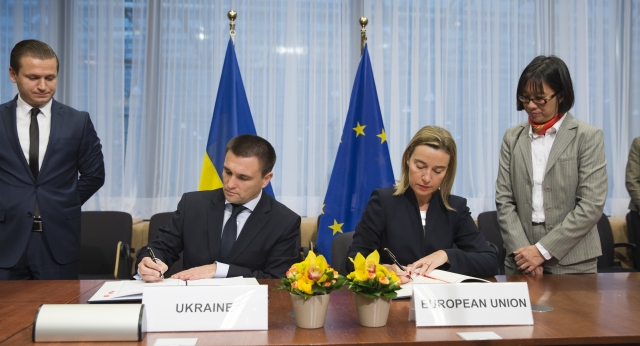EU Advisory Missions to Ukraine launched in more troubled waters
External Relations 15 December 2014While observers wait for the upcoming discussions in the last European Council of the year, the EU consolidates its presence in its frozen Eastern neighbourhood, as this month was opened by the announcement of the launch of its Mission in Ukraine.
Named “EU Advisory Mission for Civilian Security Sector Reform in Ukraine” (or EUAM Ukraine), it represents the long-awaited EU Common Security and Defence Policy response to the Ukrainian crisis. More than one year after the outbreak of the crisis that, inter alia, destabilized Ukraine and fragmented its territorial integrity, will it be a substantial tool to find a peaceful and lasting solution? Surely not alone.
During this year, Ukraine benefitted of more than 11 billion € in financial assistance, investments and grants from various sources of EU budget, while the political cooperation with the EU was tightened by the signature of the most welcome – yet far from being spotless – Association Agreement. Meanwhile, hard talks with Russia happened in any possible format on the margins of the main multilateral fora to date, from Milan’s ASEM Summit to the recent G20 in Brisbane, the coldest moment among latest meetings attended by President Putin.
On the other side, the world’s eyes slightly turned away from Ukraine due to the growing threat posed by ISIL/Da’ish, while the EU stance was softened by its internal debates and – unavoidably – from the objective limitations posed by Russian growing presence on Ukraine’s borders.
In short, EUAM was largely conceived at the end of a dramatic yet more optimistic phase, evidently influenced by the spring-like assumption that Ukraine could still be enabled to restore its territorial integrity – whether through diplomacy or via Kiev’s hard-means.

Federica MOGHERINI, EU High Representative for Foreign Affairs and Security Policy and Pavlo KLIMKIN, Minister for Foreign Affairs of Ukraine, sign the “State of Mission Agreement” for EUAM Ukraine – Photo credits: Council of the EU
EUAM was legally established in July 2014, together with the appointment of its first Head of Mission, the Hungarian Kálmán Mizsei. As most of EU missions and operations, it has a non-executive mandate – meaning it will mainly focus on advisory functions, given a sufficient level of political buy-in from Ukrainian authorities.
The Mission aims to support rule of law and democracy in the country through targeted assistance in pursuing a reform agenda in justice, police, security and home affairs. The over-arching question of inclusivity, as well as human rights, will be the leit motiv crossing all dimensions of its activities.
However, compared to the day of its launch in July, its seems already a very ambitious mandate, for a medium-sized mission budgeted with an average of 13 million € per year. In the Decision launching its set-up, the Council is indeed affirming that EUAM should “reorganise and restructure the security services in a way which permits recovering control and accountability over them” – i.e. on its whole territorial branches.
Steered by the political authority of the Council, EUAM will act together with the OSCE “Special Monitoring Mission” as an operational tool to help stabilizing the country. If conditions will not worsen again, it will slowly help rebuilding a solid base for Ukrainian security and justice sector, waiting for both parties to effectively implement the “Minsk protocol”. Signals coming from the fading intensity of the conflict in eastern regions are still too fragile be taken for granted.
A progressive normalization could be pursued only with a full appropriation by Ukrainian authorities – with the newly-appointed Government – and opposed groups in the east. Which, in turn, implies less interference in the Ukrainian territory.
That is certainly one of the evident reasons behind NATO’s announcement to deploy the first “Spearhead” of its Rapidness Action Plan in Eastern Europe. NATO leaders wish to produce a long-lasting deterrence effect, with the twofold goal of reassuring Eastern European countries and preventing Russia from taking further steps westwards. Under this terrifying balance progresses should be sought with continued diplomatic action and full inclusivity of the Ukrainian people.
A grim landscape that could be brightened up only if last initiatives will exceed their own expectations.


